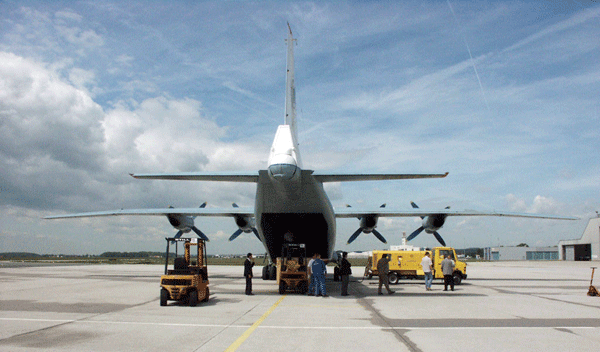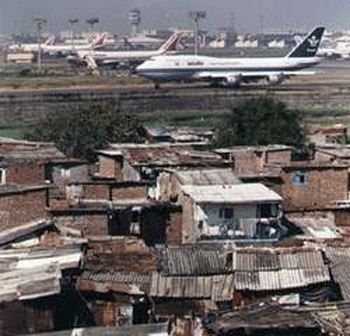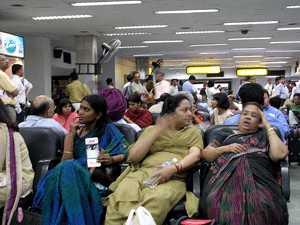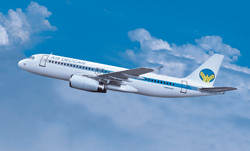Report
From India
SriLankan
Lifts India

From a “small”
carrier transporting a few selected goods, SriLankan Airlines has taken
one giant step in launching dedicated freighter services from Coimbatore
to Colombo.
It was a cherry waiting to be picked and
SriLankan Airlines was the first one off the mark.
For quite sometime now, the air carrier
has been enhancing its services into India.
To put it in proper perspective, the efforts
of the air carrier has matched any other major global airlines operating
in the country.
Today, SriLankan Airlines has one of the
highest number of flights: 77 frequencies across 11 destinations in India.
That includes its exclusive Coimbatore freighter
service that started operations just around a month ago.
The twice-a-week Coimbatore-Colombo freighter
service has brought a lot of response from industry.
 “Our
service to Coimbatore enhances our strategic objective to connect major
industrial centres throughout the Subcontinent with Colombo, which is
the Hub in the Ocean,” said Nalin Rodrigo, Head of Cargo at SriLankan. “Our
service to Coimbatore enhances our strategic objective to connect major
industrial centres throughout the Subcontinent with Colombo, which is
the Hub in the Ocean,” said Nalin Rodrigo, Head of Cargo at SriLankan.
“Our freighter is a ‘flying
truck' that serves many industries by carrying cargo rapidly and efficiently.”
To SriLankan’s credit, the service
is possibly the only one of its kind in India where it is handling the
ground operations on its own.
The service has been having teething problems,
a general feature in the air cargo business.
To begin with, the carrier introduced its
AN12 freighter on a Coimbatore-Colombo route.
Slated to transport 14 tons, the freighter
has been getting a payload of around 10 tons.
That, however, has not worried the airline.
Response from Coimbatore industry has been
overwhelming and it hopes to achieve the desired payload capacity soon.
The Coimbatore freighter service has made
SriLankan Airlines the first to tap the engineering companies and the
textile units operating in Tirupur, about 100 km away from the airport
at Coimbatore.
Dedicated freighter service has also afforded
SriLankan Airlines the opportunity to look at other avenues in the air
cargo segment in India.
It has already formulated plans to introduce
an exclusive freighter service from Pune, which is in close proximity
to Mumbai.
The carrier’s foray to Pune comes
in the wake of Maharashtra registering an exponential growth rate in exports
of agricultural commodities other than vaccines.
SriLankan Airlines has, in fact, already
started talking to the state’s agricultural body along with industrial
units to gauge the load factors.
Sources said that if the load was anywhere
around nine tons, the carrier would start its services.
SriLankan Airlines often refers to its island
home as a hub in the ocean and India is its major market.
That it has been able to carve out a niche
for itself in over-crowded Indian aviation business has been due to a
number of reasons.
Over a period of time, the airline has managed
to move away from its stature as a “small” carrier of goods
tucked away in the belly hold.
These days, SriLankan Airlines planes are
transporting perishables, finished leather, garments, and much more.
To top it all, the airline can now boast
of a dedicated trucking network, which has gone a long way to lend muscle
to its growth in the country.
Just this week SriLankan Airlines Group
said it had an after-tax profit of 1.37 billion rupees (USD$13.57 million)
for the fiscal year to last March 31, a drop of 75.6% compared to income
of LKR5.64 billion in the prior fiscal year.
But when you figure that the numbers include
fall out from last December's devastating tsunami and soaring fuel prices,
maybe a different measure of performance need be applied in this case.
Moreover it is generally acknowledged that
SriLankan Airlines was a beacon of hope and strength soaring above the
crises while delivering the goods during the past turbulent year.
The cargo division contributes around 16-18
per cent of the total revenue generated by SriLankan Airlines. In the
financial year 2004-05, the airlines handled about 10,000 tons of cargo,
25 per cent more than the corresponding period.
This year’s target is 15 percent more.
SriLankan Airlines sources feel that if
the procedures were simplified in India, the air cargo business would
take off.
These sources pointed out that the import
formalities must become easier, while rules for trans-shipment cargo need
to be done away with.
(Tirthankar Ghosh)
India’s
Airports Lag In Development
India’s race to becoming a world economic
power in the next few years, “ as predicted by world economists,”
received a big jolt recently.
The government’s
bid to privatize two of the
major international airports in the capital city of New Delhi and the financial
capital Mumbai, at a cost of Rs 10,000 saw two of the front runners bidding
for the modernization deal back off.
Privatization
was hyped as the only cure for all the problems that the airports have been
going through.
Last week (September 13)
the big Larsen & Toubro-Piramal-Hochtief combine, announced that it
would not be bidding for the Delhi airport’s modernization and expansion
project.
“Indian airports trail
their global counterparts on almost every parameter, be it the number of
flights handled per hour, non-aeronautical revenues or amenities and ambience,”
Cyrus Guzder, Chairman, AFL was quoted as saying.
 |
 |
In plain speaking India’s airports
are in a mess.
Over the last five years, there has been
virtually no investment or improvement in the infrastructure.
And the situation does not look rosy at
all.
The falling cost of air travel tied to low-cost
carriers has led to unprecedented growth in the number of Indians traveling
by air.
Passenger growth at India’s airports,
in fact, during 2004 was the highest in the world.
Given the current situation, things are
bound to go from bad to worse.
In 2002, while there were 1.4 million international
passengers landing in Indian airports from 107,700 flights, in 2004, the
number of passengers jumped up to 1.9 million and the flights to 162,000.
On the domestic front, in 2002, there were
2.6 million passengers from 402,300 flights.
The number rose to a whopping 4 million
passengers and the number of flights increased to 558,000.
The silver lining to the gloomy story is
that there are still six consortia left in the technical and financial
bidding process to rebuild the airports.
The Ministry of Civil Aviation has received
half a dozen bids for modernization at Mumbai Airport and five bids to
rebuild Delhi.
The top Civil Aviation bureaucrat, Ajay
Prasad said those in the race for upgrading and managing the Delhi airport
were Reliance Airport Developers (Anil Ambani Group) with Aeropuetos Services
Auxilliare (ASA); the GMR-Fraport consortium; Sterlite Group with Macquarie
Bank and Aeroports de Paris (ADP); Pan India Paryatan (Essel Group) with
TAV investment of Turkey; and DS Construction with Munich Airport.
All of the aforementioned along with the
GVK Industries-South African Airports consortium is also in the race for
Mumbai airport.
The technical evaluation is scheduled to
take at least a month after which the two airports could be handed over
to the private managers.
One of the main objections put up by the
private consortia is the removal of squatters from the airport area.
FlyingTypers talked to some experts to find out which of the
airport projects could be economically feasible for the private managers
and most said Delhi would be more viable.
While there are few squatters in Delhi,
the problem has become acute in Mumbai.
In addition, Delhi has the potential to
be developed as an international hub for low cost airlines and cargo traffic
in South Asia, and offer a direct challenge to traffic now flying into
Singapore's Changi airport.
But before modernization for the two international
gateway airports of India—New Delhi and Mumbai can take off, planners
will have to deal with employees of the Airport Authority of India (AAI)
- the central authority responsible for the maintenance, upkeep and performance
of all 130 airports in the country.
Last last week airport employees unexpectedly
put their foot down on the privatization scheme.
A joint action body of AAI employees called
for a countrywide strike on September 29.
For now, AAI employees have started wearing
black badges to protest privatization efforts.
The combative mood of AAI employees has
already started creating problems for the bidders in the privatization
process.
Though they do not like to be quoted, off-record
many executives of the bidding companies indicated that they would have
second thoughts about participating in further bidding until labor foment
is resolved.
(Tirthankar Ghosh)
Air Deccan Guarantees Lowest Fare
 Air
Deccan, India’s first low cost carrier, is determined
to remain the lowest fare carrier. Air
Deccan, India’s first low cost carrier, is determined
to remain the lowest fare carrier.
While most passenger carriers in the country have resorted to cutting
fares, Air Deccan has thrown an open challenge to them: “Prove that
you are the lowest in the market.”
Air Deccan is offering free tickets to passengers who buy other airlines’
tickets at lower fares than theirs.
If a passenger finds another airline cheaper than Air Deccan while purchasing
tickets at the airport counter, all he or she has to do is buy that ticket
and approach the Air Deccan airport counter.
If it is cheaper than Air Deccan, the carrier says it will fork over a
ticket free.
However, the devil is in the details, as usual.
The ticket has to be purchased between September 13, 2005 and September
30, 2005, for travel during the same period.
The deal is open only for direct flights on Air Deccan Airbus sectors
(all Airbus sectors are long-haul sectors).
Since its inception in August 2003, Air Deccan has carried over 2 million
passengers, covering 36 domestic destinations
Changi Backs Down
Singapore's Changi Airport,
which was one of the bidders in the privatization process scheme of the
Delhi and Mumbai
airports, has quit the race. The move is, however viewed
as a temporary break since Changi is interested in taking up airport projects
in southern India. For the uninitiated, southern India is where most of
the information technology action is. Incidentally, the Singapore company
is involved in the designing of Surat
airport in Gujarat State
in the west of India. (TG)
Indus Launches India Next Month
Another of India's booze barons, Kapil
Mohan of Mohan Meakins,
has taken the path that Kingfisher's Vijay
Mallya has shown. Mohan is all set to launch Indus Airways
next month (October). However, unlike Mallya who has all the frills of
a high-cost airline along with low fares, Kapil Mohan's Indus
Airways will be in the low-cost category. Indus will take
off on its maiden commercial flight with a fleet of Bombardier
CRJ-200 50-seater jets. According to a source at the airline:
"The initial fleet is leased. We feel that the CRJ is best suited
for our airline model.” The airline will hub operations at the already
overcrowded Delhi airport.
Indus will offer connections to major metros like Mumbai,
Chennai, Kolkata
and Bangalore and north
Indian towns.
|



